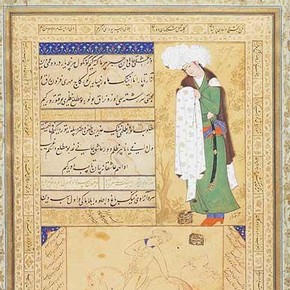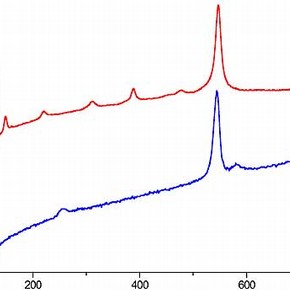Conservation Journal
Summer 2006 Issue 53
Pigment analysis of a Persian album page

Figure 1. The Persian album page (L.6964-1980, dimensions 40.2 x 26.4 cm) (click image for larger version)
A Persian album page (L.6964-1980) is one of the most important works on paper displayed in the newly opened Jameel Gallery of Islamic Art (Figure 1). It was chosen for pigment analysis in the attempt to learn more about it and support the information currently available on its provenance and date. The album page, albeit clearly unfinished, is an early collage of several different contributions added in the sixteenth and seventeenth centuries.
The drawing of a mounted hunter in the centre of the page is signed by Riza-i Abbasi: the most important painter of Safavid Iran (active 1590-1640), whose style had a revolutionary impact on not just painting, but all art of the period. The hunter and his horse are only outlined and just a few minor details, such as part of the bridle and the hilt of the hunter's dagger, were actually painted. The painting of a standing man (top right) is attributed to Ustad Muhammad Qasim who, it has been suggested by Norah Titley of the British Library, worked under Shah 'Abbas II (reigned 1642-1666). This man is fully illuminated, and is considered to be of lesser quality than the mounted hunter.
Some of the calligraphic panels are attributed to Sultan-'Ali al-Katib al-Mashhadi, (died 1520) a key exponent of Persian calligraphy. He was described by the sixteenth-century author Qazi Ahmad as 'the cynosure of calligraphers'. The main selection of calligraphy on this album page, interestingly, is not in Persian but in Chaghatay (Eastern Turkish). According to Qazi Ahmad, Sultan-'Ali Mashhadi did copy the Turkish poetry of Mir 'Alisher Nava'i, a late fifteenth-century official and patron under the Timurid dynasty.

Figure 2. Raman spectrum of A) lazurite from the blue trousers and B) red lead from the face of the man, top right corner (click image for larger version)
The painting is in good condition, except for the blue frame that has faded. Most pigments and inks on the page were identified by Raman microscopy, a spectroscopic technique that is particularly suitable for the non-destructive analysis of art objects (Figure 2). This identified lapis lazuli in all blue areas, except for the faded border (indigo); lead white in all white areas, red lead in all orange and red decorations and carbon black in the inks. Different grades of lapis lazuli were used to achieve different shades of blue. The best quality lapis lazuli, characterized by crystals of pure lazurite (intense blue in colour), was used to make the dark blue pigment, whilst lower grades (in which the blue mineral lazurite is mixed with variable amounts of lighter coloured materials, such as calcite) were used to decorate the lighter blue areas, such as the man's trousers, top right corner. The red lead was uncharacteristically deep in colour (dark red rather than orange-red). The crimson ink used in the drawing of the horse and the pink colour used for the small flowers did not give a Raman spectrum, and under the microscope had the appearance of a red lake rather than that of an inorganic pigment.
The analysis showed that all pigments and dyes identified were consistent with the provenance and the date of production of the object.
Summer 2006 Issue 53
- Editorial
- Developing the Islamic Middle East gallery and touring exhibition
- Planning the packing for a touring exhibition
- The traveling technician - the role of a technician as courier
- Harpies - past and present
- Tiles from the tomb of Buyanquli Khan
- Pigment analysis of a Persian album page
- Collaborative investigation of the Eltenberg Reliquary
- Frankfurt Kitchen: patina follows function
- Printer friendly version